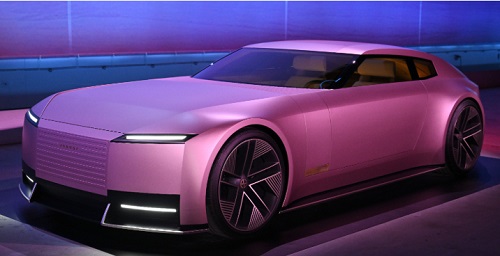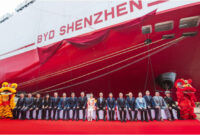The luxury automobile manufacturer Jaguar has introduced its latest electric concept vehicle, which has sparked mixed reactions, similar to a recent contentious teaser video.
Some individuals on social media described the new Type 00 model as “exciting” and “absolutely stunning,” while others dismissed it as “rubbish” and urged Jaguar’s designers to “return to the drawing board.”
Nonetheless, the automaker has indicated that the mixed response aligns with its intentions as it aims to revitalize its brand in order to boost sluggish sales.
“Jaguar must be bold and disruptive to penetrate the market and communicate our message effectively,” stated CEO Rawdon Glover in an interview with the BBC.
He emphasized that his aspiration is to re-establish Jaguar’s reputation as a luxury brand, stepping away from the strategy of producing large numbers of vehicles.
Historically, Jaguar has been the weakest segment within the Jaguar Land Rover (JLR) group, which is also responsible for manufacturing Range Rovers and Land Rover Defenders.
Since 2018, sales have plummeted from 180,000 to only 67,000 in the previous year.
Last month, JLR ceased the sale of new Jaguars in the UK entirely, in anticipation of its transition to an electric-only brand by 2026.
The company also revealed a new logo, alongside what has been labeled a “social media tease,” showcasing models dressed in bright colors without presenting any actual cars.
Many criticized the advertisement as “woke,” with Elon Musk, the CEO of rival Tesla, questioning, “Do you sell cars?”
Critics also lamented the modification of Jaguar’s iconic growling cat emblem, which has been altered and is no longer located on the car’s front.
Mr. Glover has defended this initiative, asserting that the discussion has attracted “more eyeballs” to the firm leading up to the unveiling of the new concept car this week.
“In that context… the strategy was successful,” he remarked.
“We certainly do not want to alienate any segment of our customer base… But, most importantly, our primary goal is to draw in a new audience to Jaguar’s brand to ensure we secure Jaguar’s future for the next 90 years.”
JLR announced its shift to electric vehicles in 2021, committing to keep all three of its British manufacturing plants operational as part of this strategy.
It stated that the decision to halt new Jaguar sales in the UK last month was a calculated move to “create some breathing space” before introducing its refreshed image.
The Type 00 model revealed at a Miami art fair is a concept and, therefore, will not go into mass production for public sale.
Instead, the model, characterized by its ultra-long bonnet and large wheels, offers insight into the brand’s future vehicle designs.
Mr. Glover noted that Jaguar has “ripped up the rulebook” with its new design, which is also meant to evoke the brand’s golden era.
The rebranding comes with a higher cost, as Jaguar aims to cater to the luxury market.
“Nobody requires a vehicle priced at £120,000; it’s a matter of desire,” he remarked.
“Overall, this car embodies a sense of true occasion, which we believe is somewhat lacking in the luxury electric vehicle sector,” he added.
Yet, many social media users were unimpressed by the preview.
James May, a broadcaster and former Top Gear presenter, expressed feeling “slightly disappointed” with the design and its price point.
“I expected something more futuristic,” he told the BBC. “Jaguar has claimed they will copy nothing, but there are elements of other concept cars in this new Jaguar.”
May mentioned that Jaguar vehicles have historically been “quite reasonably priced compared to, for instance, Aston Martin.”
“Therefore, I would prefer to see something priced closer to half of what they are currently proposing.”
‘Too big’
Beatrix Keim, director of the Center for Automotive Research, criticized Jaguar’s concept car as being “too large, too unrealistic.”
“This is not the right direction to take,” she said, considering that there are already sizeable vehicles available and “electric cars shouldn’t solely target the affluent.”
“Certainly, Jaguar is a luxury brand,” she added. “However, I don’t believe this is the path Jaguar needs to be on at this time, as it is also losing volume. This is not a high-volume vehicle.”
Amanda Stretton, a racing driver and automotive journalist, concurred that she felt Jaguar was heading in the “wrong direction” regarding pricing.
“The market for cars exceeding £100,000 is limited, so Jaguar is entering a market that is already highly competitive,” she said, adding that the new vehicle’s size seemed to be “utterly impractical.”
“It ought to be reduced in size by about 50% to become more functional.”
Jeff Dodds
Previously the marketing director at Honda, now serving as the chief executive of Formula E, where Jaguar competes. I’ve recently had a Jaguar iPace; it’s a great car, but it didn’t bring me joy. That’s what I seek in a vehicle, and Jaguar understands this too. Inspector Morse might not be interested, but if his grandson had just launched a cybersecurity startup, he might be.
Jaguar certainly caught attention with the launch, which was their intention. There was a genuine sense of excitement leading up to the reveal, and some guests were eagerly hoping to see an outrageous disaster. Instead, what emerged was anything but hideous; it’s incredibly distinctive. It’s noticeably larger, more daring, and more unconventional than I expected. It will certainly grab attention. While not everyone may appreciate it, I’m grateful for that.
The event itself is also radically different: it has an industrial and edgy vibe. The British grime artist and rapper Skepta wouldn’t typically fit the role of a Jaguar brand ambassador, yet he performed a DJ set among influencers and cultural icons in downtown Miami. This is a significant shift from previous events. Is it too much of a change? Perhaps. Jaguar was at risk of being relegated to past discussions, so I commend them for this move. If I owned a Type 00, I believe it would bring me joy.
Ginny Buckley
Founder of the UK EV-buying platform Electrifying.com
In Jaguar’s nine-decade history, nothing has generated as much global discourse as its controversial rebranding. However, the new logo and extravagant advertisement may soon be overshadowed by the dramatic unveiling of the Type 00.
I first encountered the car during a briefing at Jaguar Land Rover’s design studio in the Midlands, and in my more than 25 years as an automotive journalist, no vehicle has left me as awestruck as this £100,000+ all-electric grand tourer.
Indeed, it’s pink—very pink. Shown in Miami Pink and London Blue, the colors reflect the city that showcased its global reveal and Jaguar’s British roots.
In over 25 years as a motoring journalist, no vehicle has astonished me as much as this all-electric GT priced over £100,000.
The color is bound to be a focal point for many critics. I was informed by Jaguar’s design team that it’s a “production-ready” hue, which could create controversy among traditional Jaguar enthusiasts if it ends up in the final color selection.
Beyond the color, the design of the Type 00 is striking, boasting an elongated hood, a substantial monolithic grille, and front-hinged butterfly doors, while Jaguar has also eliminated the rear window.
I believe the Type 00 presents a fresh and bold appearance. My 15-year-old describes it as “peak”—which I take as a compliment.
Gerry McGovern, Jaguar’s chief creative officer, remarked, “It will make people feel uncomfortable, and it will polarize.” Of course, it will. However, if the goal was to generate conversation, they’ve certainly succeeded.
The challenge lies in whether Jaguar can swiftly transform its brand to capture the new wave of affluent young buyers it hopes will want this vehicle.
Manfredi Ricca
Global chief strategy officer at the branding consultancy Interbrand, who has worked with Bugatti and contributed to the relaunch of Mini and BMW
Let’s rewind to two weeks ago. There was little interest in Jaguar. Then out of nowhere, a 30-second video is released, and millions instantly take notice. Within just 24 hours, Jaguar becomes part of the worldwide dialogue, even without showcasing a product.
As a consequence, the anticipation for the new lineup reaches levels akin to that of a World Cup final in terms of reach and intensity—including a leak the night before the launch.
Jaguar Land Rover wasn’t aiming to evolve a thriving brand; it was about reinventing an ailing one. You can hardly ask for more from a campaign, especially one intended to rejuvenate a brand. What many commentators miss is that Jaguar Land Rover wasn’t just trying to evolve a prosperous brand but was focused on reinventing one that was struggling.
Currently, more people celebrate Jaguar’s rich history than those who actually desire its cars.
Museums may thrive solely on nostalgia, but commercial enterprises cannot—they need to transform their heritage into something that a sufficient number of customers are willing to pay for.
Jaguar, once renowned for its innovation in crafting some of the most unique vehicles globally, is seeking affection from a select few instead of being overlooked by the majority.
The concept revealed in Miami is likely to entice them—but the real test will be converting them into fans by 2025 and customers by 2026, when the cars are expected to enter the market.

Richard Exon
Co-founder of the advertising agency Joint, with prior experience working with Audi and Range Rover
Jaguar deserves recognition for its ambitious rebranding efforts. A complete departure from its past may be its best option. It aims to market its brand-new lineup to a completely different audience, so striving to become a more modern, inclusive, and provocative brand could potentially yield successful results.
However, intent alone isn’t enough if the execution is as lackluster as the derivative and disappointing video content Jaguar released prior to the launch.
Fortunately, the concept car images showcase a striking new aesthetic.
The Type 00 marks a pivotal moment in Jaguar’s 90-year legacy, representing a daring and unapologetically bold approach aimed at redefining Jaguar as a modern luxury brand suited for the 21st century, capable of profiting from selling far fewer vehicles at significantly higher price points. “It serves as our first tangible embodiment and the cornerstone for a new lineup of Jaguars that will appear unlike anything you’ve encountered before,” remarks Gerry McGovern, JLR’s chief creative officer.
The Type 00, with its exaggerated dimensions, boldly disregards Jaguar’s conventional design language. It lacks the usual Jaguar features, such as flowing curves or feline dynamism; instead, it showcases solid surfaces accented by a few sharp lines stretched tightly over large wheels and abruptly terminated by straight-edged front and rear sections. “The Type 00 demands attention, akin to the finest Jaguars of history,” states chief exterior designer Tino Segui. This is accurate, yet few may perceive it as a natural successor to the stunning E-Type that captivated audiences at the 1961 Geneva Motor Show.
The Type 00 boasts a plethora of captivating concept car details, including butterfly doors, rearview cameras concealed under pivoting brass panels along the sides, and a windowless rear hatch that operates on a pantograph mechanism. The cabin is adorned with woven textile accents and highlights of brass and travertine stone, featuring screens that emerge from the dashboard. Brass, travertine, and alabaster totems are stored within a compartment behind a powered door on the front fender, utilized to adjust the interior atmosphere by altering ambient lighting, soundscapes, and screen visuals.
Beneath its striking appearance, the foundational shape and proportions of the Type 00, along with its robust stance and elements like the textured parallel line graphics at both the front and rear (where the tail and brake lights are cleverly concealed in the upper and lower lines), hint at what is to come when Jaguar’s first all-new electric vehicle, a sleek four-door GT, debuts in 2026. “The initial production model was deliberately selected because it exemplifies the Type 00 at its purest,” confirms Jaguar managing director Rawdon Glover.
Anticipate that the upcoming GT, which will utilize the new Jaguar Electric Architecture (JEA) platform, might not feature an interior as extravagant as that of the Type 00. However, the Type 00’s innovative use of materials and colors, along with technologies like deployable displays and indirect ambient lighting, suggest that the next generation of electric Jaguars will offer far more opulent interiors compared to the outgoing internal combustion models. This is essential: Rawdon Glover indicates that the least expensive of the upcoming Jaguar EVs will start at over $120,000.
While Jaguar has unveiled images of a camouflaged GT prototype being tested in the UK, no technical specifics have been disclosed apart from an EPA-rated range of up to 430 miles and an electrical system designed to achieve 200 miles of range in just 15 minutes when using a fast charger. The GT is anticipated to be an all-wheel-drive model powered by two electric motors, featuring multi-link suspension both front and rear. This range estimate implies it will incorporate a battery pack of no less than 100 kWh.

The JEA platform has been custom-engineered to accommodate the battery beneath a low floor, enhancing handling and enabling the striking proportions hinted at by the Type 00. The second vehicle to emerge from this platform is expected to be a two-box high-performance SUV, though Jaguar insiders suggest it will have a sleeker roofline than competitors such as the Aston Martin DBX707, Ferrari Purosangue, and Lamborghini Urus. The third Jaguar utilizing the JEA platform is likely to take the form of a two-door sports car available in both coupe and convertible styles.
Gerry McGovern asserts that the Jaguar Type 00 is not designed to “seek affection from all.” He is correct: The Type 00 elicits strong reactions. However, it’s also the most forward-thinking Jaguar in half a century; the first model since the XJS to challenge conventional notions of Jaguar’s design. The Type 00 and the strategy behind it represent a significant risk. But JLR stands to gain little from the status quo. Although purists may object, reality dictates that too few individuals appreciated the former Jaguar models enough to ensure profitability. A fresh perspective on what Jaguar could be, and should be, was essential. Whether you admire it or detest it, this is its visage.


